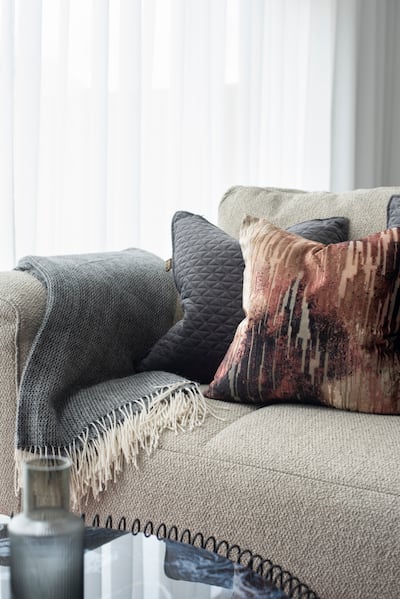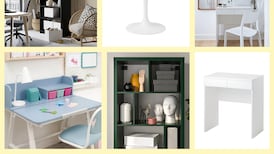When planning the design of our homes, aesthetics typically take centre stage. We can get caught up in choosing the right colours, furniture, and decor to make our rooms look good. But to make your home feel good, you’ve got to think about more than just how it looks. That’s where the idea of multisensory design comes in. It’s about creating a space that engages all your senses – sight, touch, sound, smell and even taste. So, if your home feels like it’s missing something, here are some ways to make small adjustments to transform it into an inviting and harmonious space that will delight all five of your senses.
Sight: colour and light
The two most important considerations for appealing to the sense of sight are colour choice and lighting. The paint colours you choose can profoundly affect the mood and atmosphere of a space, while lighting can alter those colours depending on the orientation of the room and the type of bulbs you use.
When selecting paint colours, start by deciding the mood you want to create in the room. Warm colours will tend to create a stimulating effect, while cooler colours, such as blues, soft greens and greys, will produce a more calming and relaxing atmosphere.
When it comes to lighting, the trick is to balance artificial and natural light. Too much artificial light will result in a space that feels clinical. But if it is under-lit, everything will appear gloomy and uninviting. Always try to maximise the amount of natural light in your rooms. Window dressings such as curtains and blinds can contribute to blocking natural light. Pull back curtains clear from the windows to maximise daylight. Remove items on windowsills that might obstruct light, such as plants or bulky ornaments. Avoid pelmets or decorative blinds that can block sunlight and make a room feel dark.
READ MORE
When tackling artificial lighting, make sure you use warm-toned light bulbs. This will make the room feel cosy, and where possible, swap your switches for dimmers so you can control the light level in the room, be it low ambient light to relax and entertain or brighter light to read and work.
[ How to embrace maximalist design in small spacesOpens in new window ]
Touch: texture and comfort
Mixing fabrics in different textures is a great way to add depth and interest to a room while encouraging interaction and enhancing comfort. Incorporate tactile materials like plush throws, soft cushions and textured upholstery in spaces where you like to relax and unwind.
Pay attention to everyday touchpoints such as door handles, stair handrails, and taps. Choose high-quality fittings that feel good and function well, making daily interactions more enjoyable.
Introduce rugs to hard flooring such as wood or tiles to add warmth and texture underfoot. Consider fitting wall-to-wall curtains in living spaces and bedrooms. Not only are they a practical investment helping to insulate against drafts, but they also help to make the space feel more comfortable and luxurious.
Smell: fragrance and air quality
Our sense of smell significantly impacts our emotions and memories, making it essential to creating a comfortable and inviting home environment.
Proper ventilation is crucial, especially in areas prone to moisture build-up, like kitchens and bathrooms. Open windows regularly for fresh air and install ventilation systems that expel air outdoors to prevent the accumulation of harmful fumes and maintain air quality throughout your home.
Be aware of potential sources of harmful chemicals, such as harsh cleaning products or volatile organic compounds (VOCs) released from furnishings. To maintain a healthy environment, choose natural cleaning products whenever possible and prioritise chemical-free, VOC-free options for items such as carpets, flooring, upholstery, and paint. This will help keep your home smelling fresh while promoting a healthier living space.
House plants are a wonderful addition to any room; not only do they look beautiful but they have a wealth of health benefits both mental and physical – from purifying the air and filtering harmful chemicals to reducing stress levels.

Taste: culinary delights
Although taste might not be an immediate consideration in home design, it plays a vital role in our culinary experiences and overall enjoyment of food. Thoughtfully designing your kitchen can stimulate your sense of taste and foster a more engaging environment.
Our perception of taste begins with visual presentation. We ‘eat with our eyes’, so investing in visually appealing crockery and glassware can help to elevate mealtime enjoyment. Store food in a way that creates visual appeal, using attractive containers and organising your pantry and refrigerator for easy access.
Extend the culinary experience beyond the kitchen by creating inviting dining spaces that foster connection and conversation. Comfortable seating, ambient lighting, and tasteful decor elevate the atmosphere, ensuring that every meal shared with family and friends is memorable.
[ Brighten up your home – indoors or outdoors – with a new rugOpens in new window ]
Sound: harmony and tranquillity
Sound plays a significant role in shaping our mood, wellbeing and perception of our surroundings. By thoughtfully managing acoustics within your home, you can create a serene environment that nurtures tranquillity.
To reduce external noise from traffic or alarms, invest in quality windows. Upgrading from single to double glazing can significantly diminish unwanted sounds. For apartments or terraced homes, install a layer of soundboard on shared walls to maintain privacy and tranquillity. Opting for solid internal doors instead of hollow ones will minimise sound transmission between rooms.
Strategic layout planning is crucial. Position quiet spaces away from noisy areas and consider floor insulation to minimise sound travel. Additionally, enhance your living space with soothing sounds such as gentle music or nature recordings and invest in quality sound systems for an immersive auditory experience.











